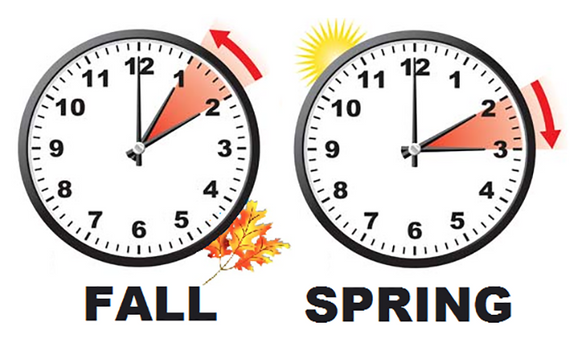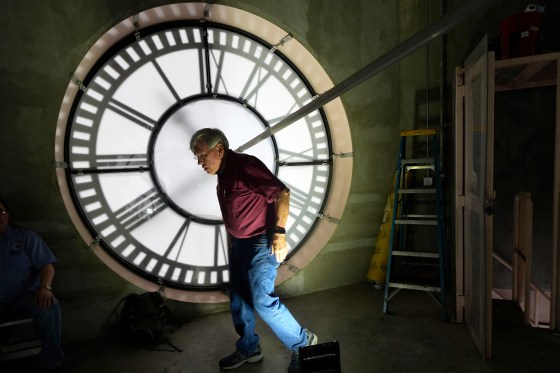
What to know about daylight saving time.
What to know about daylight saving time
It’s finally time for longer hours of sunlight during the spring and summer months. Here’s what you need to know as the clocks move forward early Sunday (09/03/2025) morning.

After a long winter with short days, it’s finally time to move forward into spring.
On Sunday, clocks across the US will move from 1:59 a.m. to 3 a.m.
Here’s what you need to know about daylight saving time and why we change clocks twice a year in the US.
How long will daylight saving time last?
Daylight saving time will begin Sunday and last until Nov. 2. Standard time will be in effect Sunday, Nov. 3, 2024.
The clock change in spring is different from fall time. Unlike fall, when we gain an extra hour and clocks fall back, we lose an hour in spring.
But that translates to longer days and brighter evenings as the spring and summer months begin. This will remain in effect until we turn the clocks back to standard time, which goes into effect again on Nov. 2 as we prepare for winter and begin an era of shorter days.
Why do we change the clocks?
According to the U.S. Department of Astronomical Applications, the U.S. has been observing daylight saving time since 1918 with the passage of the Standard Time Act. This was an attempt to extend summer daylight hours by moving the sunset forward one hour.
Daylight saving time was not fully accepted at first — it was quickly repealed in 1919, making changing clocks a local affair. The practice was officially reinstated in the early days of World War II and was followed from 1942-45, according to the department.
Daylight saving time varied by state until 1966 with the passage of the Uniform Time Act, which standardized the dates of daylight saving time but allowed states and local areas to opt out of the practice if they didn’t want to participate.
Since the passage of that act, the standardized dates have been changed over the years, according to the department.
But the dates have remained the same since 2007. Since then, daylight saving time begins on the second Sunday in March and ends on the first Sunday in November.
Are there any states that do not follow the time change?
Yes. People in Hawaii and most of Arizona won’t lose an hour of sleep Sunday night. Both states don’t observe daylight saving time and don’t change clocks twice a year, according to the Department of Astronomical Applications.
Is anyone trying to change this practice?
The US Senate passed the Sunshine Protection Act in March 2022, which would make daylight saving time permanent year-round and usher in an era of changing clocks. Under the bill, Hawaii and most of Arizona would continue to observe standard time year-round.
But the bill got stuck in the House of Representatives, so the US will continue to flip clocks twice a year until new legislation is passed in the House and Senate and then signed by the current president.
President Donald Trump addressed the practice this week when a reporter asked when he was going to “get rid” of daylight saving time.
“I agree people want more lights late at night, but some people want more lights earlier because they don’t want to take their kids to school in the dark,” he said, describing the issue as “50-50.”
“But a lot of people like it one way, a lot of people like it the other way. It’s very similar,” he said. “And usually, I think when that happens, what else do we have to do?” Shortly after winning the election last year, Trump said he and Republicans would try to “eliminate” daylight saving time, calling it inconvenient and expensive.
It was unclear at the time whether he was talking about eliminating daylight saving time or making it permanent. Nearly all U.S. states have considered legislation to avoid changing the clocks, which would remain on standard or daylight saving time year-round.
In the past six years, 20 states have passed bills or resolutions to codify year-round daylight saving time, according to the National Conference of State Legislatures. But since federal law currently doesn’t allow year-round daylight saving time, those states are waiting until Congress passes a bill to make the change.

Is the U.S. the only country that changes clocks?
No, many other countries follow some version of “summer time,” whether it’s daylight saving time or their own version. However, not all countries do so on the same time schedule as the U.S.
For example, in the Southern Hemisphere, the seasons are swapped, so the start and end dates of “summer time” are reversed from ours, according to the Department of Astronomical Applications.
What do health experts say?
Some studies suggest that using daylight saving time year-round could reduce the amount of traffic accidents and crime, but many experts are against a long day year-round.
According to some sleep experts, the sun should reach its highest point in the sky at noon, or solar time, which is what happens during standard time.
A June 2022 study found that people whose clock time was not closely aligned with the sun had a 22% higher rate of road accidents than those who lived within 30 minutes of solar time.
Correction (March 8, 2025, 3:26 p.m. ET): A previous version of this article misstated how often the clocks change. It happens twice a year, not every six months.

What happens during daylight saving?
In the spring, clocks move forward one hour, meaning the sun sets one hour later in the evening and rises one hour later in the morning. Digital clocks on cellphones will change automatically. Analog clocks and any clock or watch that does not adjust automatically will need to be reset manually.
What does Daylight Saving Time mean?
Every year on the second Sunday in March, people across the country turn their clocks forward or “spring” them one hour, thereby “losing” an hour of sleep and getting more daylight in the evening. On the first Sunday in November, clocks are turned back one hour so they “fall back,” thereby gaining an hour of sleep.
What is Daylight Saving in the USA?
Daylight Saving Time is the time between March and November when most Americans adjust their clocks forward one hour. We lose an hour in March to have more daylight in summer evenings (as opposed to gaining an hour in autumn).
Why is Daylight Saving observed?
Let’s say we did away with Daylight Saving Time. Here’s how it would happen…
Daylight Saving Time (DST) is observed to make better use of daylight and save energy. It involves moving clocks forward by one hour during the summer months.

How DST works
DST causes the sun to rise and set later, giving people more light in the evening.
This also leads people to spend more time outdoors and less time indoors, which reduces electricity consumption.
DST was first adopted by several countries during World War I, including Germany, Great Britain, Australia, and the United States.
DST controversy
However, the actual effect of DST on overall energy use is disputed.
Some studies have shown that the one-hour change disrupts body rhythms that normally follow the Earth’s rotation.
Others have argued that DST can cause sleeplessness at bedtime and drowsiness when awakening in the dark in the morning.
Some argue that year-round standard time best matches human circadian biology and offers a variety of benefits for public health and safety.
DST in India
India does not observe DST because countries near the equator do not have much variation in daylight hours between seasons.
Why is it called Daylight Saving?
History and Information – The idea of Daylight Saving Time came from Benjamin Franklin. The main purpose of Daylight Saving Time (called “summer time” in many places around the world) is to make better use of daylight. We change our clocks during the summer months so that one hour of daylight moves from morning to evening.
also read – latest information about lumon industries here .
You may also like
You may be interested
South African ambassador no longer welcome in US
Rubio says South African ambassador no longer welcome in US...
Why did the Trump administration revoke the visa of Ranjani Srinivasan, an Indian scholar at Columbia University?
Why did the Trump administration revoke the visa of Ranjani...
What is adolescence, everything about it.
Adolescence Adolescence is the transitional stage from childhood to adulthood...
1 comment
Archives
Calendar
| M | T | W | T | F | S | S |
|---|---|---|---|---|---|---|
| 1 | 2 | 3 | 4 | 5 | 6 | |
| 7 | 8 | 9 | 10 | 11 | 12 | 13 |
| 14 | 15 | 16 | 17 | 18 | 19 | 20 |
| 21 | 22 | 23 | 24 | 25 | 26 | 27 |
| 28 | 29 | 30 | 31 | |||
Leave a Reply